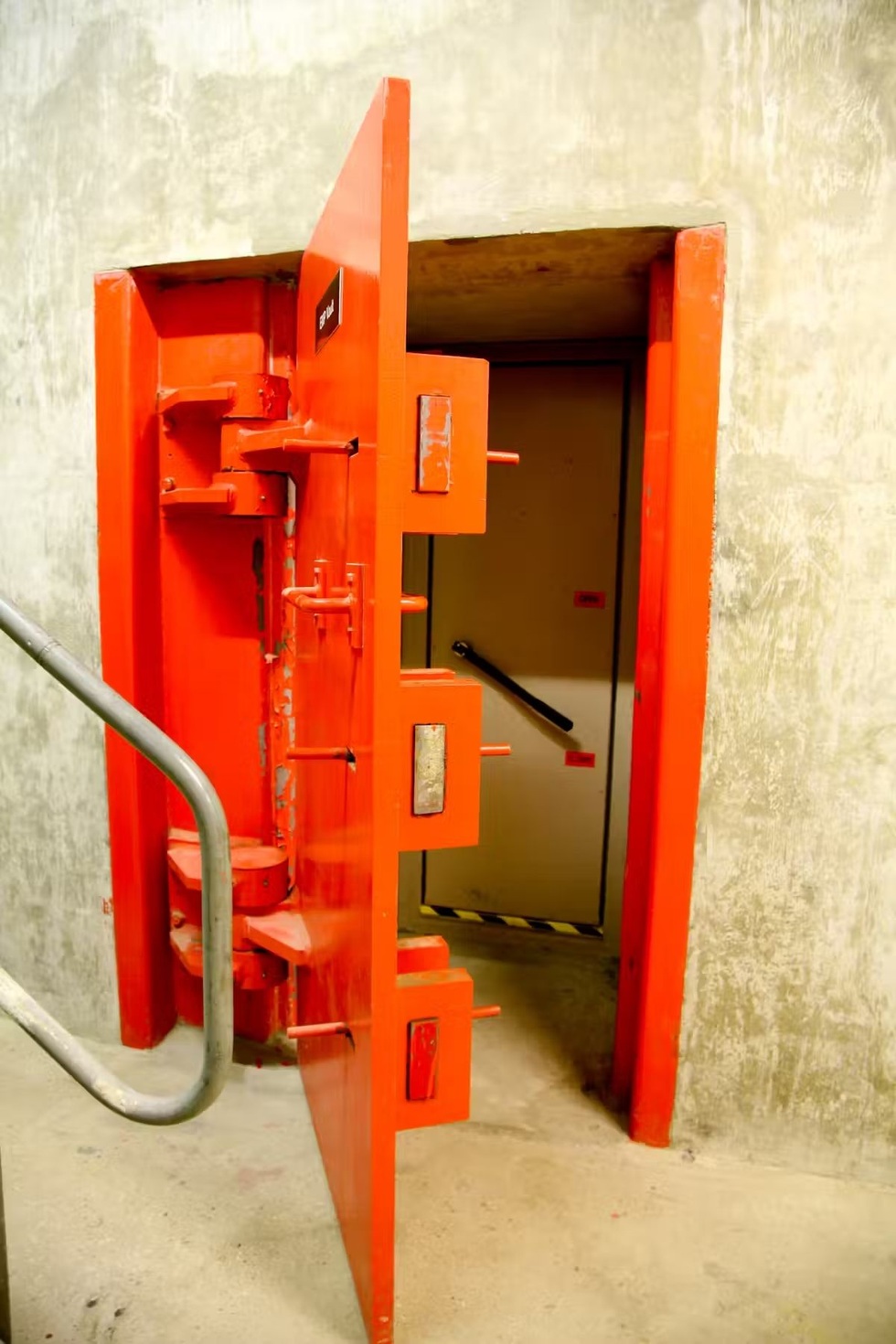Their mission is not to protect people, but to protect the most precious asset of our time: data.
Amidst the tranquil countryside of rural Kent, England, stands a 3-meter-high barbed wire fence surrounding a giant grassy knoll. Few would suspect that, 30 meters below ground, a state-of-the-art cloud computing center is operating.
This was once a nuclear bunker, built in the 1950s as a command center for the Royal Air Force's radar network, where soldiers were glued to screens, looking for signs of Soviet bombers.
Today, after the Cold War ended, it is operated by Cyberfort Group as a super-secure data center.
Anthropologically, these establishments continue a long-standing tradition of mankind: keeping the most precious things underground, just as our ancestors buried gold, silver, and jewels in burial mounds. The only difference is that the treasures of this era are the numbers 0 and 1.
Cyberfort is not alone. Around the world , the legacy of the Cold War is being reborn.
Old bomb shelters in China, abandoned Soviet command centers in Kyiv, and US Department of Defense bunkers have all been repackaged as “impenetrable” data storage locations.

A Tencent data center is under construction in Guizhou province, China (Photo: Wired).
Even mines and caves are being reused, such as the Mount10 AG complex - "Swiss Fort Knox" deep in the Alps or the Arctic World Archive (AWA) in Norway.
If nuclear bunkers were architectural reflections of the fear of annihilation, today's data bunkers speak to a new existential threat: the terrifying prospect of data loss.
Data - the gold mine of the era
Tech experts have hailed data as a “gold mine”—a metaphor made all the more vivid by the fact that data is stored in abandoned mines. As the value of data increases, so does the fear of losing it.

The thick steel door outside the Cyberfort bunker (Photo: Wired).
For individuals, it means lost memories and valuable work. For corporations and governments , a serious data loss can threaten development and national security.
Recent cyber attacks on Jaguar, Marks & Spencer and the ransomware incident that bankrupted TravelEx are examples of this. Faced with the prospect of a “doomsday” due to data loss, businesses are turning to these shelters.
Inside the reception area of the Cyberfort bunker, a concrete cylinder is displayed behind a glass case, revealing the nearly meter-thickness of the bunker's walls. Its rugged, solidity stands in stark contrast to the light-hearted metaphor of the data "cloud."
The truth is, there is no “cloud,” just machines; when data is uploaded to the “cloud,” it is sent to servers located in buildings called data centers.
These physical infrastructures are the backbone of nearly every activity in modern society: from credit card payments, transportation, healthcare, national security, to sending an email or watching a movie.
"Most people only think about cyber security - hackers, viruses - and ignore the physical aspect," says Rob Arnold, chief digital officer at Cyberfort. "Conventional data centers are built quickly, they're not designed to withstand bombs or theft."
Amid geopolitical tensions, internet infrastructure is becoming a high-value target.
“Customers may not survive the apocalypse, but their data will,” Rob summarizes.
The entrance to the bunker is a heavy steel door designed to withstand a thermonuclear blast. Inside, the air is cool and musty; to get deeper, one must pass through a metal mantrap, then descend a steel staircase.
These blast doors and concrete walls seem antiquated in the face of invisible data streams. But that would be a mistake.
Think of the “cloud” as a house that holds all of our digital assets. No matter how secure it is, it is still on the ground and can be affected by the real world.

The blast-proof door at the Cyberfort bunker, inside which is where the data center server system is located (Photo: Wired).
It can be broken into by thieves, hit by natural disasters like hurricanes, or even encounter small risks like animals chewing on cables. When this “house” fails and stops working, even for a few minutes, the financial consequences are huge, potentially running into millions of dollars.
The Cloudflare, Fastly, Meta, and CrowdStrike incidents of 2024 are prime examples of this fragility.
Geography is also extremely important. Locating a data center in a specific country helps customers comply with that country's data sovereignty laws. Contrary to the original illusion of a borderless internet, geopolitics is reshaping the "cloud."
As the final blast doors of the Cyberfort bunker opened, the presence of the server room - the heart of the fortress was revealed.
Hundreds of servers are neatly stacked in racks, whirring in a strictly controlled environment to prevent overheating.
To maintain these optimal conditions, data centers consume enormous amounts of energy and water. Globally, they account for about 1% of total electricity demand – more than some countries consume.
Amid the AI frenzy that’s fueling the construction of ever more energy-hungry data centers, the internet is slowly being called “the world’s biggest coal-powered machine.” Despite efforts to use renewable energy, the reality is clear: Conserving data at all costs leaves a huge carbon footprint.
Eternal legacy or life debt?
“The bunker is built to last, like the pyramid,” said Richard Thomas, head of security at Cyberfort.

Server room inside Cyberfort bunker (Photo: Wired).
The comparison is profound. The bunker is designed to transport its contents through time. Likewise, tech giants like Apple and Google are turning cloud storage into a lifetime service.
They encourage users to archive rather than delete, because that locks customers into increasingly expensive subscription plans.
Device storage space is getting smaller and smaller, forcing users to rely on the "cloud". And once committed to a provider, switching is extremely difficult.
Users are becoming digital hoarders, tethered to services they don’t really own. Many tech experts argue that if we truly consider data to be gold, perhaps users should be paid to store it, rather than the other way around.
The survival of data – whether stored in vaults or “lifetime” cloud accounts – depends on market volatility, the resilience of the infrastructure and the organizations behind it.
Source: https://dantri.com.vn/cong-nghe/hoi-sinh-di-san-thoi-chien-tranh-lanh-thanh-cac-trung-tam-du-lieu-20250928194557290.htm


![[Photo] National Assembly Chairman Tran Thanh Man chairs the 8th Conference of full-time National Assembly deputies](https://vphoto.vietnam.vn/thumb/1200x675/vietnam/resource/IMAGE/2025/9/29/2c21459bc38d44ffaacd679ab9a0477c)


![[Photo] General Secretary To Lam receives US Ambassador to Vietnam Marc Knapper](https://vphoto.vietnam.vn/thumb/1200x675/vietnam/resource/IMAGE/2025/9/29/c8fd0761aa184da7814aee57d87c49b3)
![[Photo] General Secretary To Lam attends the ceremony to celebrate the 80th anniversary of the post and telecommunications sector and the 66th anniversary of the science and technology sector.](https://vphoto.vietnam.vn/thumb/1200x675/vietnam/resource/IMAGE/2025/9/29/8e86b39b8fe44121a2b14a031f4cef46)
![[Photo] Many streets in Hanoi were flooded due to the effects of storm Bualoi](https://vphoto.vietnam.vn/thumb/1200x675/vietnam/resource/IMAGE/2025/9/29/18b658aa0fa2495c927ade4bbe0096df)































































































Comment (0)